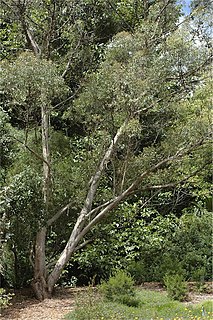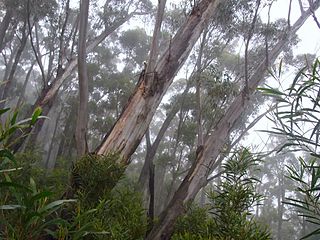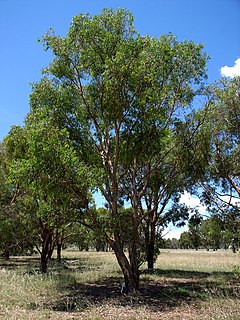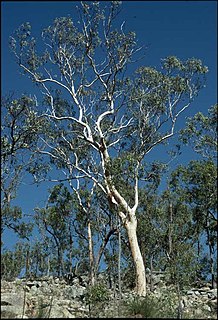
Eucalyptus macrorhyncha, commonly known as the red stringybark, is a species of medium-sized tree that is endemic to eastern Australia. It has rough, stringy, grey to brown bark, lance-shaped adult leaves, flower buds in groups of between seven and eleven, white flowers and hemispherical fruit.

Eucalyptus olsenii, commonly known as the Woila gum, is a species of small tree that is endemic to a restricted area on the Southern Tablelands of New South Wales. It has smooth bark with rough bark on the lower trunk, lance-shaped to curved adult leaves, flower buds in groups of seven, white flowers and barrel-shaped or urn-shaped fruit.

Eucalyptus leucoxylon, commonly known as yellow gum, blue gum or white ironbark, is a species of small to medium-sized tree that is endemic to south-eastern continental Australia. It has smooth yellowish bark with some rough bark near the base, lance-shaped or curved adult leaves, flower buds in groups of three and cylindrical, barrel-shaped or shortened spherical fruit. A widely cultivated species, it has white, red or pink flowers.

Eucalyptus rubida, commonly known as candlebark, ribbon gum or white gum, is a species of small to medium-sized tree that is endemic to south-eastern Australia. It has smooth bark, sometimes with rough bark at the base, lance-shaped or curved adult leaves, flower buds in groups of three, white flowers and cup-shaped, hemispherical or bell-shaped fruit.

Eucalyptus stenostoma, commonly known as the Jillaga ash, is a small to medium-sized tree in that is endemic to a restricted part of New South Wales. It has rough, fissured bark on the lower trunk, smooth creamy white bark above, lance-shaped adult leaves, flower buds in groups of thirteen to nineteen or more, white flowers and spherical fruit with a small opening.

Eucalyptus parramattensis, commonly known as the Parramatta red gum or drooping red gum, is a species of small to medium-sized tree that is endemic to eastern New South Wales. It has smooth, mottled bark, lance-shaped to curved adult leaves, flower buds in groups of seven, white flowers and hemispherical fruit.

Eucalyptus campanulata, commonly known as the New England blackbutt, gum-topped peppermint or New England ash, is a tree that is endemic to eastern Australia. It has rough, finely fibrous greyish bark on the trunk and larger branches, lance-shaped to curved adult leaves, flower buds arranged in groups of between eleven and fifteen, white flowers and cup-shaped to conical fruit.

Eucalyptus scias, known as the large-fruited red mahogany, is a species of small, straggly to medium-sized tree that is endemic to the high rainfall coastal areas of New South Wales. It has rough, fibrous bark on the trunk and branches, lance-shaped adult leaves, flower buds in groups of three or seven, white flowers and cup-shaped, conical or bell-shaped fruit.

Eucalyptus kartzoffiana, commonly known as the Araluen gum, is a species of medium-sized tree that is endemic to a small area of southeastern New South Wales. It has rough, fibrous or flaky bark on part or most of its trunk, lance-shaped or curved adult leaves, flower buds in groups of three, white flowers and sessile, bell-shaped fruit.

Eucalyptus langleyi, commonly known as the green mallee ash or albatross mallee, is a species of mallee that is endemic to a small area of New South Wales. It has mostly smooth grey to yellowish bark, lance-shaped to curved adult leaves, flower buds in groups of seven, white flowers and cup-shaped to barrel-shaped fruit.

Eucalyptus pachycalyx, commonly known as the shiny-barked gum, is a species of tree that is endemic to north-eastern Australia. It has smooth, pale grey, mottled bark, lance-shaped or curved adult leaves, white flowers and cup-shaped or hemispherical fruit.

Eucalyptus effusa, commonly known as rough-barked gimlet, is a species of mallee or small tree that is endemic to Western Australia. It has thin, rough bark on the base of the trunk, smooth bark above, linear to narrow lance-shaped adult leaves, flower buds arranged in groups of seven, white flowers and cup-shaped to conical fruit.

Eucalyptus fraseri, commonly known as Balladonia gum, is a species of tree or mallet that is endemic to Western Australia. It has smooth white to greyish bark, lance-shaped or curved adult leaves, flower buds in groups of seven or nine, white flowers and cup-shaped, conical or hemispherical fruit.

Eucalyptus georgei, commonly known as Hyden blue gum, is a species of tree or mallet that is endemic to Western Australia. It has smooth bark, glossy green, lance-shaped adult leaves, glaucous flower buds in groups of between seven and eleven, creamy white flowers and conical to cup-shaped fruit.

Eucalyptus leucophloia, commonly known as snappy gum or migum, is a species of small tree or mallee that is endemic to northern Australia. The indigenous Mangarayi and Yangman peoples know the tree as mirndir, the Ngarluma name it as malygan and Yindjibarndi peoples know the tree as majgan. It has smooth, powdery bark, lance-shaped to egg-shaped adult leaves, flower buds usually in groups of seven, white flowers and cup-shaped, barrel-shaped or hemispherical fruit.

Eucalyptus pruinosa, commonly known as silver box, silver leaf box, apple box or smoke tree, is a species of tree or a mallee that is endemic to northern Australia. The Jaminjung peoples know the tree as yarrirra or jarnbiny, the Jaru as wararn and the Wagiman as wararn. It has rough, fibrous to flaky bark on the trunk and branches, a crown composed of juvenile, glaucous, heart-shaped to broadly elliptical leaves arranged in opposite pairs, flower buds arranged in groups of seven on the ends of branches, creamy white to pale yellow flowers and cylindrical to conical fruit.

Eucalyptus scyphocalyx, commonly known as goblet mallee, is a species of mallee that is endemic to southern areas of Western Australia. It has smooth bark, lance-shaped adult leaves, flower buds in groups of three or seven, creamy white flowers and cup-shaped to cylindrical fruit.
Eucalyptus paedoglauca, commonly known as the Mount Stuart ironbark, is a small to medium-sized tree that is endemic to a small area in Queensland. It has rough, dark ironbark, lance-shaped adult leaves, flower buds in groups of seven, white flowers and cup-shaped fruit. It is only known from a few hills near Townsville.

Eucalyptus pauciflora subsp. niphophila, commonly known as snow gum, is a small tree or large shrub that is native to a few mountain peaks in eastern Australia. It has smooth bark, glossy green, lance-shaped to egg-shaped or elliptical leaves, flower buds in groups of between nine and fifteen, white flowers and cup-shaped, hemispherical or conical fruit. It differs from other subspecies of E. pauciflora in having more delicate, pedicellate flower buds and smaller leaves.

Eucalyptus pauciflora subsp. pauciflora, commonly known as snow gum, cabbage gum or white sally is a tree or mallee that is endemic to eastern Australia. It has smooth bark, glossy green, lance-shaped, curved or elliptical leaves, flower buds in groups of between nine and fifteen, white flowers and cup-shaped, hemispherical or conical fruit.


















